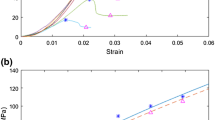Summary
This paper addresses the phenomena of mechanical creep and deformation in rock formations, coupled with the hydraulic effects of fluid flow. The theory is based on Biot's poroelasticity, generalized to encompass viscoelastic effects through the correspondence principle. Based on the resultant poroviscoelastic theory, stress and deformation analyses are performed. The interactions between the fluid pore pressure diffusion and the elastic/viscoelastic rock matrix deformation are illustrated via two important examples. First, the problem of a borehole subject to a non-hydrostatic stress state, but deforming under plane strain condition, is examined. Second, a cylinder under generalized plane strain conditions is solved. Three rocks, Berea Sandstone, Danian Chalk, and a deep water Gulf of Mexico Shale, covering a wide range of permeabilities, are considered. The significance of poro-and viscoelastic time-dependent effects is discussed.
Similar content being viewed by others
References
Biot, M. A.: General theory of three-dimensional consolidation, J. Appl. Phys.12, 155–164 (1941).
Detournay, E., Cheng, A. H.-D.: Fundamentals of poroelasticity. In: Comprehensive rock engineering: principles, practice & projects. Vol. II, Analysis and design method (Fairhurst, C., ed.) pp. 113–171. Pergamon 1993.
Biot, M. A.: Mechanics of deformation and acoustic propagation in porous media. J. Appl. Phys.33, 1482–1498 (1962).
Cleary, M. P.: Elastic and dynamic regimes of fluid-impregnated solids, with diverse micro-structure. Int. J. Solids Struct.14, 795–819 (1978).
Biot, M. A.: Theory of deformation of a porous viscoelastic anisotropic solid. J. Appl. Phys.27, 459–467 (1956).
Biot, M. A.: Nonlinear and semilinear rheology of porous solids. J. Geophys. Res.78, 4924–4937 (1973).
Tabaddor, F., Little, R. W.: Interacting continuous medium composed of an elastic solid and incompressible Newtonian fluid. Int. J. Solids Struct.7, 825–841 (1971).
Wilson, R. K., Aifantis, E. C.: On the theory of consolidation with double porosity. Int. J. Eng. Sci.20, 1009–1035 (1982).
Coussy, O.: Mecanique des milieux poreux. Paris: Editions Technip 1991.
Vgenopoulou, I., Beskos, D. E.: Dynamic behavior of saturated poroviscoelastic media. Acta Mech.95, 185–195 (1992).
Abousleiman, Y., Cheng, A. H.-D., Jiang, C., Roegiers, J.-C.: A micromechanically consistent poroviscoelasticity theory for rock mechanics applications. Int. J. Rock Mech. Mining Sci. Geomech. Abstr.30, 1177–1180 (1993).
El Rabaa, A. W., Meadows, D. L.: Laboratory and field application of the strain relaxation method. SPE 15072, 56th California Regional Meeting, Oakland, CA, April 2–4, 1986.
El Rabaa, A. W.: Determination of the stress field and fracture direction in the Danian chalk. in: Rock at great depth (Maury, V., Fourmaintraux, D., eds.) pp. 1017–1024 Rotterdam: Balkema 1989.
Warpinski, N. R., Teufel, L. W.: Author's reply to discussion of: A viscoelastic constitutive model for determining in-situ stress magnitudes from anelastic strain recovery of core. SPE Production Eng. 287–289, August 1989.
Nakken, S. J., Chritensen, T. L., Marsden, R., Holt, R. M.: Mechanical behavior of clays at high stress levels for wellbore stability applications. In: Rock at great depth (Maury V., Fourmaintraux, D., eds.). Rotterdam: Balkema 1989.
Mody, F. K., Hale, A. H.: A borehole stability model to couple the mechanics and chemistry of drilling fluid/shale interaction. SPE/IADC 25728, Amsterdam, February 1993.
Haimson, B. C., Roegiers, J.-C., Zoback, M. D.: (eds.) Proc. 2nd Int. Workshop hydraulic fracturing stress measurements, University of Wisconsin-Madison, Minneapolis, 1988.
Warpinski, N. R., Teufel, L. W. A viscoelastic constitutive model for determining in-situ stress magnitudes from anelastic strain recovery of core. SPE Production Eng. 272–280, August 1989.
Rice, J. R., Cleary, M. P.: Some basic stress-diffusion, solutions for fluid saturated elastic porous media with compressible constituents, Rev. Geophys. Space Phys.14, 227–241 (1976).
Flügge, W.: Viscoelasticity. Waltham: Blaisdell 1967.
Biot, M. A., Willis, D. G.: The elastic coefficients of the theory of consolidation. J. Appl., Mech.78, 91–96 (1956).
Nur, A., Byerlee, J. D.: An exact effective stress law for elastic deformation of rock with fluids. J. Geophys. Res.76, 6414–6419 (1971).
Zimmerman, R., Somerton, W., King, M.: Compressibility of porous rocks. J. Geophys. Res.91, 12765–12777 (1986).
Taylor, D. W., Merchant, W.: A theory of clay consolidation accounting for secondary compression. J. Math. Phys.19, 167–185 (1940).
Corapcioglu, M. Y., Brutsaert, W.: Viscoelastic aquifer model applied to subsidence due to pumping. Water Resour. Res.13, 597–604 (1977).
Christensen, R. M.: Theory of viscoelasticity, 2nd. ed. New York: Academic Press 1982.
Caroll, M. M.: Mechanical responce of fluid-saturated porous materials. In: Theoretical and applied mechanics. Proceedings of the 15th Int. Cong. of Theoretical and Applid Mechanics, Toronto, 1980 (Rimrott, F. P. J., Tabarrok, B. eds.) pp. 251–262.
Detournay, E., Cheng, A. H.-D.: Poroelastic response of a borehole in a non-hydrostatic stress field. Int. J. Rock Mech. Mining Sci. Geomech. Abstr.25, 171–182 (1988).
Lekhnitskii, S. G.: Theory of elasticity of an anisotropic elastic body. San Francisco: Holden-Day 1963.
Saad, A.: Elasticity theory and applications. New York: Pergamon Press 1974.
Brady, B. H. G., Bray, J. W.: The boundary element method for determining stresses and displacements around long openings in a triaxial stress field. Int. J. Rock. Mech. Min. Sci. Geomech. Abstr.15, 21–28 (1978).
Cryer, C. W.: A comparison of the three-dimensional consolidation, theories of Biot and Terzaghi. Q. J. Mech. Appl. Math.16, 401–412 (1963).
Abousleiman, Y., Cheng, A. H.-D., Cui, L., Detournay, E., Roegiers, J.-C.: Mandel's problem revisited Géotechnique (to appear).
Author information
Authors and Affiliations
Rights and permissions
About this article
Cite this article
Abousleiman, Y., Cheng, A.H.D., Jiang, C. et al. Poroviscoelastic analysis of borehole and cylinder problems. Acta Mechanica 119, 199–219 (1996). https://doi.org/10.1007/BF01274248
Received:
Issue Date:
DOI: https://doi.org/10.1007/BF01274248




